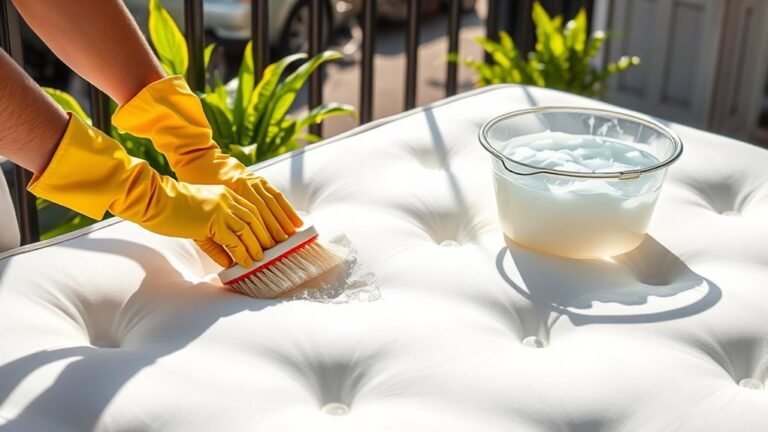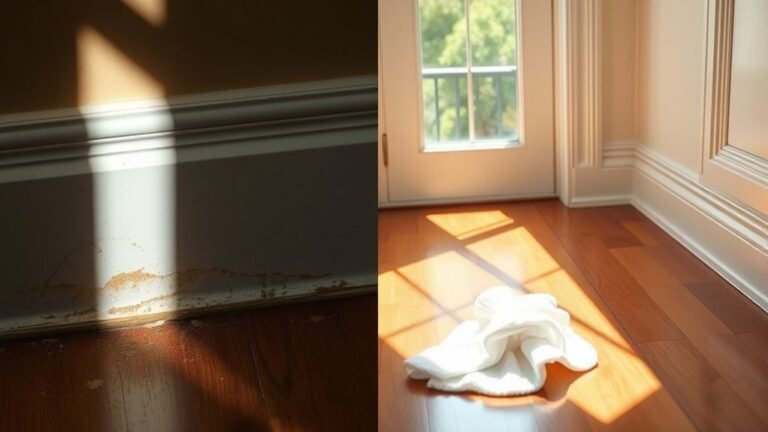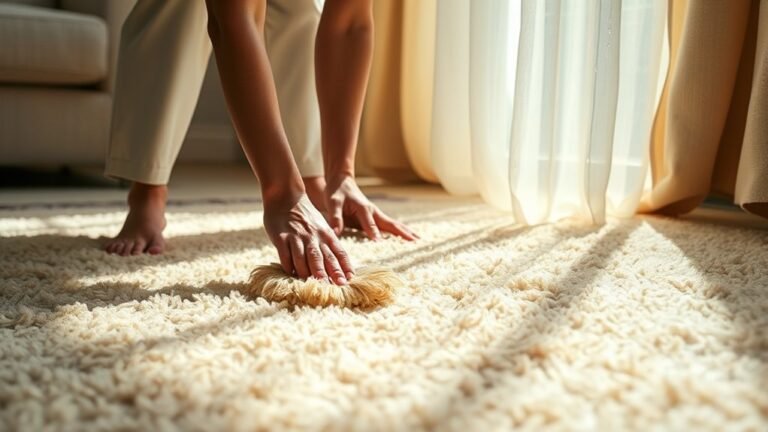Essential Tools for Cleaning Rug
You’ll need specific tools to clean your rug effectively and preserve its quality. Start with a vacuum cleaner featuring adjustable suction to protect fibers of different densities. Use a carpet beater to dislodge deep dirt and a soft-bristled brush for delicate areas. Spot-treat stains with a spray bottle and appropriate cleaning solution. For tough grime, a carpet extractor or steam cleaner works well. Don’t forget rubber squeegees for pet hair and protective gloves. Discover more specialized tools to guarantee thorough rug care.
Vacuum Cleaner With Adjustable Suction

A vacuum cleaner with adjustable suction is essential for effectively maintaining rugs of various materials and pile heights. You need a device that offers precise control over suction power to prevent damage to delicate fibers while ensuring thorough dirt removal. Adjustable settings allow you to tailor the vacuum’s intensity—higher suction for dense, low-pile rugs and lower suction for fragile, high-pile or antique rugs. This flexibility maximizes cleaning efficiency without compromising the rug’s integrity. When selecting a vacuum, prioritize models with easily accessible controls that let you switch suction modes seamlessly. This technical capability empowers you to maintain your rugs independently, preserving their appearance and lifespan. Mastering adjustable suction settings means you’re equipped to handle diverse rug types, granting you the freedom to keep your floors impeccably clean with confidence. Using the right tools is important since scrubbing with the wrong tools can damage delicate surfaces, so selecting a vacuum with adjustable suction helps avoid such damage.
Carpet Beater or Rug Beater
Carpet beaters, often called rug beaters, deliver a mechanical method for dislodging embedded dust and debris from your rugs without relying on electricity. By rhythmically striking the rug, these tools break down compacted dirt that vacuums might miss, enhancing your rug maintenance routine. Using a carpet beater allows you to control cleaning frequency precisely, ensuring deep cleaning without over-wearing fibers. To maximize effectiveness, hang your rug securely and beat evenly across its surface. This method preserves the rug’s integrity while efficiently removing allergens and particles, granting you freedom from dependence on power tools. Incorporating a rug beater into your cleaning arsenal complements modern techniques, providing a reliable, energy-free solution for maintaining your rugs’ longevity and appearance. Regular maintenance, like using a rug beater, can help in preventing stains and mold growth by reducing dirt and moisture accumulation.
Soft-Bristled Brush
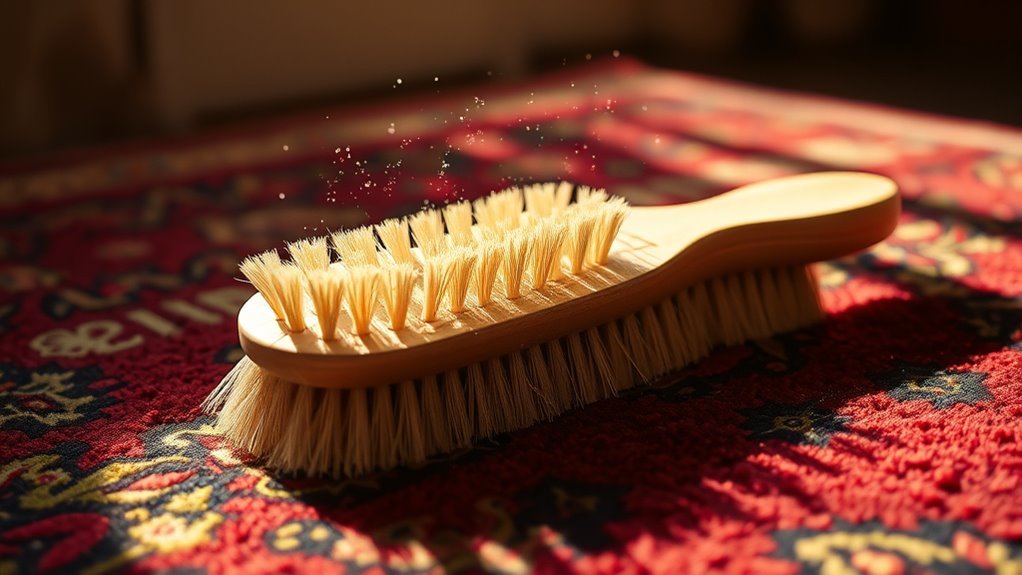
When using a soft-bristled brush, you’ll gently lift dirt without damaging delicate rug fibers. This tool is essential for preserving the integrity of your rug while ensuring thorough cleaning. Proper technique involves brushing in the direction of the fibers to avoid fraying and maintain texture. It is important to choose cleaning methods compatible with your rug’s material, as different materials react differently to cleaning techniques.
Gentle Dirt Removal
Soft-bristled brushes excel at removing dirt from rugs without damaging delicate fibers. When you need to tackle surface stains or light soil, gentle scrubbing with these brushes guarantees effective cleaning while preserving the rug’s integrity. Their fine bristles reach into fibers, loosening dirt without abrasion.
| Feature | Benefit | Application |
|---|---|---|
| Soft bristles | Protects delicate fibers | Ideal for wool, silk, and synthetics |
| Ergonomic handle | Reduces hand fatigue | Enables precise control |
| Compact size | Access to tight areas | Perfect for edges and corners |
Fiber Preservation Techniques
Although delicate fibers require careful handling, using a soft-bristled brush allows you to preserve their structure while effectively removing embedded dirt. This tool is essential across various fiber types—whether natural like wool and silk or synthetic blends—because it minimizes abrasion and prevents fiber breakage. When employing preservation methods, you should gently brush in the direction of the rug’s pile to maintain fiber alignment and avoid loosening. The brush’s fine, flexible bristles penetrate deeply without damaging the strands, ensuring dirt extraction without compromising fiber integrity. Consistent use of a soft-bristled brush supports longevity by reducing wear from harsh cleaning techniques. By integrating this method into your routine, you maintain the rug’s aesthetic and structural quality, granting you freedom from frequent replacements and preserving your investment effectively.
Carpet Shampoo or Cleaning Solution
When selecting a carpet shampoo or cleaning solution, you need to evaluate the formulation’s compatibility with your rug’s material and stain type. Homemade solutions often combine precise measurements of common ingredients like vinegar and baking soda to target specific soil conditions without damaging fibers. Applying these solutions correctly—using controlled amounts and appropriate agitation—ensures maximum cleaning efficiency without overwetting or residue buildup. It is also important to test cleaning solutions in inconspicuous areas to prevent damage before full application.
Types of Carpet Shampoos
Since the effectiveness of rug cleaning heavily depends on the type of carpet shampoo or cleaning solution used, understanding their formulations is crucial. You’ll encounter enzymatic cleaners designed to break down organic stains, and surfactant-based shampoos that lift dirt and oils effectively. For stubborn spots, specialized carpet stain removers target specific residues like wine or pet urine. If you value sustainability, eco friendly options utilize biodegradable ingredients with minimal VOCs, reducing environmental impact without compromising cleaning power. Selecting the right shampoo hinges on your rug’s material and the nature of its soiling. Avoid harsh chemicals that can damage fibers or leave residues attracting dirt. By choosing a solution aligned with your rug’s needs and your personal standards, you guarantee thorough cleaning while preserving the rug’s integrity and your freedom to enjoy a fresh, healthy space.
Homemade Cleaning Solutions
If you want full control over the ingredients in your carpet cleaning solution, homemade mixtures offer a customizable and effective alternative to commercial shampoos. A common and potent option is a vinegar solution, combining white vinegar with water in a 1:1 ratio. This mixture acts as a natural disinfectant and deodorizer, breaking down grime without harsh chemicals. Adding a few drops of lemon juice enhances its stain-removal capabilities due to its mild acidity and fresh scent. For tougher stains, you can increase the lemon juice concentration slightly, but always test on a small area first to avoid discoloration. By preparing your own carpet shampoo, you guarantee the formula suits your rug’s material and your personal standards, granting you the freedom to clean safely and effectively.
Application Tips and Tricks
Three key application techniques guarantee your carpet shampoo or cleaning solution works effectively without damaging your rug. First, always test a small, inconspicuous area to check for colorfastness and fiber reaction. Second, apply the solution evenly, avoiding over-saturation which can weaken fibers and promote mold. Use a spray bottle or sponge for controlled application, respecting manufacturer guidelines on cleaning frequency to maintain ideal rug care. Third, agitate gently with a soft-bristle brush to loosen dirt without abrading fibers. After treatment, ensure thorough drying by increasing airflow or using a wet-dry vacuum. This prevents residue buildup and preserves rug integrity. By mastering these techniques, you maintain your rug’s appearance and extend its lifespan, granting you the freedom to enjoy a clean, vibrant living space without worry.
Spray Bottle for Spot Treatments
A spray bottle for spot treatments is an essential tool for targeting specific areas of your rug that require immediate attention. It allows precise application of various cleaning solution options, ensuring effective spot treatment techniques without over-saturating the fibers. You can control the spray intensity, adapting to the stain type and rug material, which preserves the rug’s integrity and extends its lifespan.
| Cleaning Solution Options | Spot Treatment Techniques |
|---|---|
| Enzyme-based cleaners | Light misting, blotting gently |
| Vinegar-water mix | Targeted spray, quick agitation |
| Commercial stain removers | Direct application, dwell time |
Using a spray bottle lets you maintain control, enabling freedom to clean efficiently while protecting your rug’s texture and color. It is important to use gentle blotting rather than rubbing to avoid damaging the fibers during spot cleaning.
Microfiber Cloths or Towels
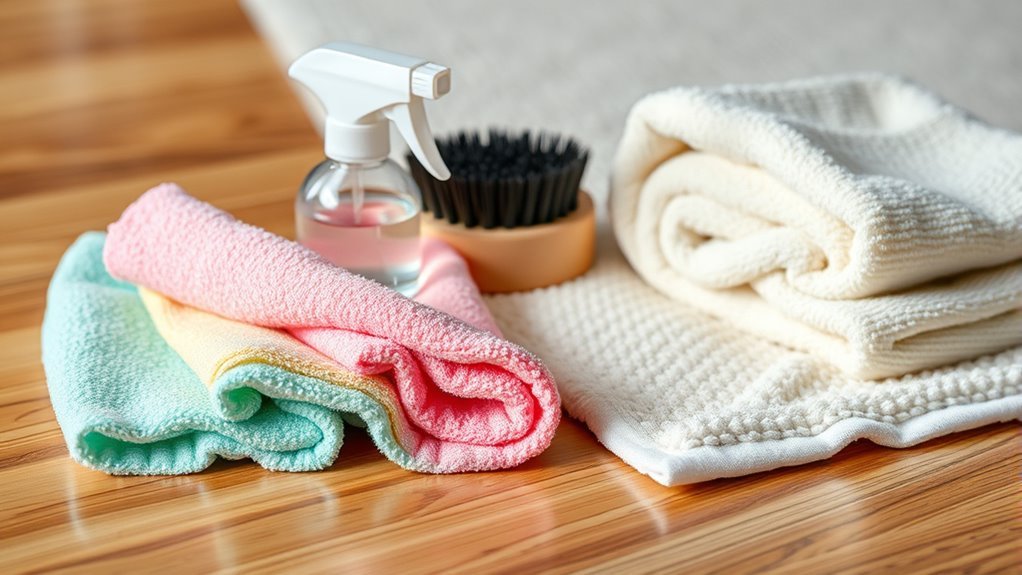
You’ll find microfiber cloths excel at trapping dirt and moisture due to their fine synthetic fibers, making them ideal for delicate rug surfaces. Using precise wiping motions, you can lift stains without damaging fibers or leaving residue. To maintain their effectiveness, wash them separately without fabric softeners and air dry to preserve their texture and absorbency. Regular maintenance, including vacuuming regularly, complements the use of microfiber cloths to keep rugs clean and fresh.
Material Benefits
Microfiber cloths or towels offer distinct advantages for rug cleaning due to their unique fiber structure and high absorbency. Their densely woven synthetic fibers create a large surface area that efficiently traps dust, dirt, and moisture without damaging delicate rug fibers. This superior material durability supports frequent use, allowing you to clean your rugs regularly without rapid wear or loss of effectiveness. Because microfiber can absorb up to seven times its weight in liquid, it minimizes drying time and reduces the risk of mold or mildew growth. Additionally, these cloths require less detergent, preserving the rug’s integrity while maintaining cleanliness. Choosing microfiber tools empowers you to maintain your rugs efficiently, granting you the freedom to keep your living space fresh without compromising on material longevity or cleaning frequency.
Cleaning Techniques
Although cleaning rugs with microfiber cloths or towels might seem straightforward, mastering specific techniques guarantees ideal results without damaging fibers. You’ll want to dampen the cloth lightly—never soaking it—to avoid waterlogging which can warp rug fibers. For stain removal, blot gently rather than rubbing to lift the stain without spreading. When paired with steam cleaning, microfiber towels efficiently absorb loosened dirt, enhancing overall cleanliness.
| Technique | Application | Benefit |
|---|---|---|
| Light Dampening | Prepping cloth | Prevents fiber damage |
| Blotting | Stain removal | Avoids stain spreading |
| Circular Motion | General cleaning | Loosens dirt effectively |
| Steam Cleaning Aid | Post-steam wipe | Absorbs moisture/dirt |
| Dry Towel Finishing | Final pass | Removes residual dampness |
These precise techniques empower you to clean rigorously while preserving rug integrity.
Maintenance Tips
Mastering cleaning techniques is only part of preserving your rug’s condition; proper maintenance of your microfiber cloths and towels guarantees they remain effective tools. To guarantee peak performance, conduct routine cleaning of these textiles by washing them separately in warm water with a mild detergent, avoiding fabric softeners that diminish absorbency. Air drying or low-heat tumble drying preserves fiber integrity. After each use, thoroughly rinse and wring out cloths to prevent residue buildup that compromises stain prevention. Store them in a dry, dust-free environment to inhibit bacterial growth. By maintaining your microfiber cloths and towels with this disciplined regimen, you preserve their high absorbency and cleaning power, giving you the freedom to tackle spills and stains confidently, protecting your rug’s longevity and appearance with every use.
Carpet Extractor or Steam Cleaner
When you need a deep and thorough cleaning for your rugs, a carpet extractor or steam cleaner is one of the most effective tools available. Understanding the carpet extractor benefits and steam cleaner comparison helps you choose the right device for your cleaning freedom. Extractors remove dirt using detergent and suction, while steam cleaners sanitize with high-temperature vapor. To maintain your rug’s quality, it is also important to remove loose dirt and debris before using these tools.
| Feature | Carpet Extractor |
|---|---|
| Cleaning Method | Detergent + suction |
| Dry Time | 1-2 hours |
| Best For | Deep dirt & stains |
| Steam Cleaner Comparison | Uses steam, no detergent |
| Ideal Use | Sanitizing & surface cleaning |
Both tools enhance rug longevity, but your needs dictate the best fit.
Rubber Squeegee for Pet Hair Removal
A rubber squeegee is a highly effective tool for removing pet hair embedded in rug fibers, especially when traditional vacuuming falls short. Its unique design utilizes static friction and flexible rubber edges to lift and gather hair that vacuums often miss. You’ll appreciate the rubber squeegee benefits, such as its ability to reach deep into dense pile rugs without damaging fibers. Simply pull the squeegee across the rug surface at an angle to collect hair into manageable piles for easy removal. This method guarantees effective pet hair extraction, reducing allergens and improving rug appearance. Durable and reusable, a rubber squeegee offers an economical yet powerful solution, granting you freedom from persistent pet hair challenges with minimal effort and maximum efficiency. Using a rubber squeegee is a great technique for cleaning carpets by gathering stubborn hair into clumps for easier removal.
Baking Soda for Deodorizing
Deodorizing rugs effectively requires a substance that can neutralize odors without damaging fibers, and baking soda fits this role perfectly. Its alkaline nature absorbs acidic and basic molecules, eliminating malodors rather than masking them. To maximize baking soda benefits with proven deodorizing techniques, follow these steps:
- Evenly sprinkle a generous layer of baking soda over the rug surface.
- Gently massage it into the fibers to reach embedded odors.
- Let it sit for at least 30 minutes—longer for intense smells.
- Thoroughly vacuum to remove all residue and trapped particles.
This method preserves fiber integrity while granting you freedom from harsh chemicals, ensuring your rug smells fresh and clean without compromising its texture or color. Baking soda’s non-toxic profile makes it an indispensable tool for rug maintenance. For enhanced odor control, you can combine baking soda with essential oils to create a pleasant scent while deodorizing.
Gloves and Protective Gear
Proper gloves and protective gear are essential for safeguarding your hands and skin during rug cleaning tasks that involve chemicals, dirt, or potential allergens. You’ll want protective gloves that resist punctures and chemicals, plus safety goggles to shield your eyes from splashes or airborne particles. Using the right gear guarantees freedom to clean effectively without risking irritation or injury.
| Gear Type | Purpose |
|---|---|
| Protective Gloves | Chemical resistance, grip |
| Safety Goggles | Eye protection from splashes |
| Respirator Mask | Filters dust and allergens |
| Protective Apron | Shields clothing and skin |
Equip yourself properly to maintain safety and precision throughout your rug cleaning process.
Frequently Asked Questions
How Often Should I Deep Clean My Rug?
Did you know that dust mites can double in population every 20 days in dirty rugs? To keep your space healthy, follow frequency guidelines recommending deep cleaning your rug every 12 to 18 months. Regular maintenance tips, like weekly vacuuming and spot treating stains promptly, extend the time between deep cleans. This approach guarantees your rug stays fresh and allergen-free, giving you the freedom to enjoy your home without worrying about hidden contaminants.
Can I Use Essential Oils With Baking Soda on Rugs?
You can use essential oils with baking soda on rugs to freshen and deodorize them effectively. Mixing a few drops of essential oils into baking soda allows you to sprinkle this blend across your rug. After letting it sit for 15-30 minutes, vacuum thoroughly to remove residue. Just be cautious with delicate fibers and test a small area first to avoid discoloration or damage, ensuring your rug stays vibrant and clean.
What’S the Best Way to Dry a Rug After Cleaning?
Did you know improper drying can increase mold growth risk by up to 50%? To dry your rug effectively, use a combination of drying techniques like air circulation and heat application. Position fans strategically to promote airflow, and consider a dehumidifier to remove moisture from the air. If you have drying equipment like a carpet dryer or blowers, use them to speed up the process. Avoid direct sunlight to prevent fading and maintain your rug’s integrity.
Are Homemade Cleaning Solutions Safe for All Rug Types?
You shouldn’t assume homemade solutions are safe for all rug materials. Different fibers like wool, silk, or synthetic blends react uniquely to ingredients like vinegar or baking soda. Testing a small, hidden area first is essential to avoid damage or discoloration. Tailoring your homemade solutions to your rug’s specific materials guarantees effective cleaning without compromising its integrity, giving you the freedom to maintain your rug confidently and responsibly.
How Do I Prevent Color Fading During Rug Cleaning?
Ever wondered how to keep your rug’s colors vibrant after cleaning? To guarantee color protection, always test cleaning solutions on a small, hidden area first. Avoid harsh chemicals that strip dyes, and opt for gentle, pH-balanced cleaners. After washing, use a dye setting product designed to lock in colors and prevent fading. Proper drying away from direct sunlight also preserves dye integrity, giving you freedom to enjoy your rug’s vivid hues longer.


